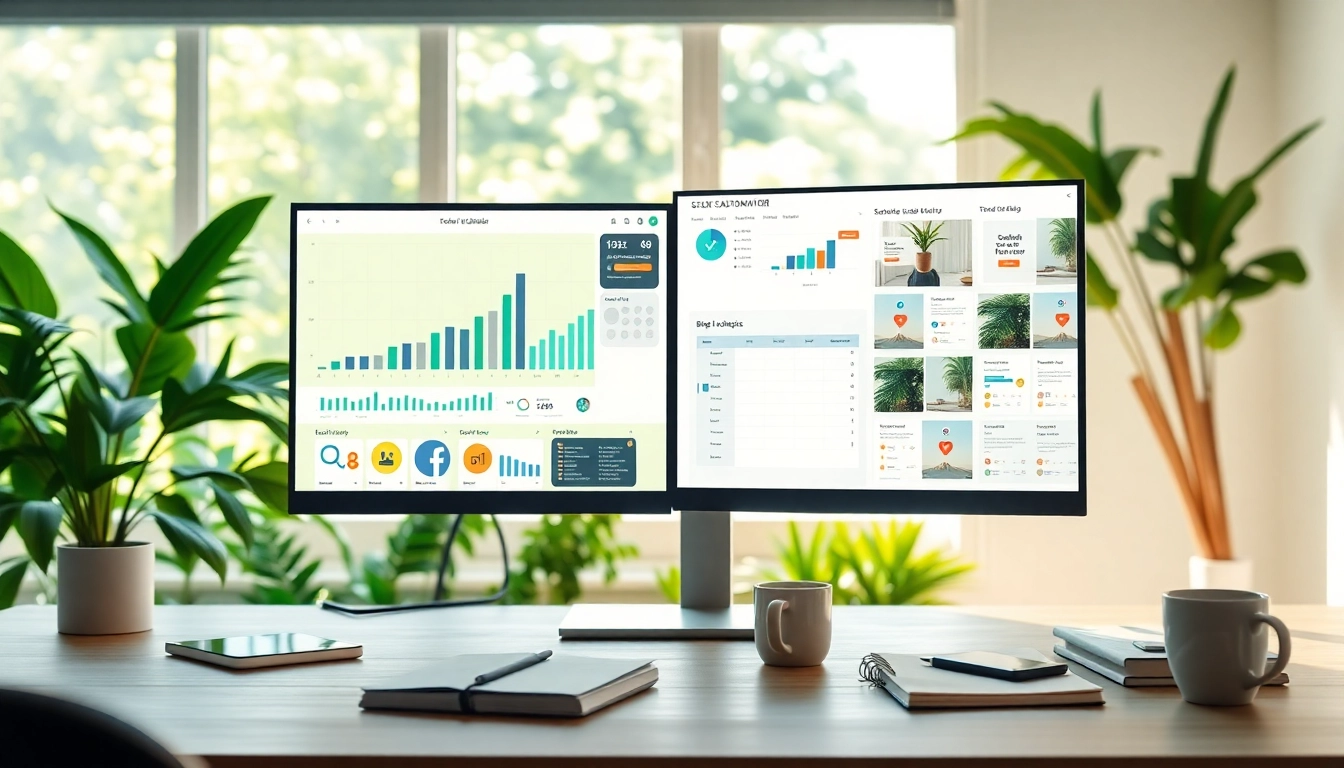Understanding Social media and blog automation
What is Social media and blog automation?
Social media and blog automation refers to the use of software tools and systems to streamline and manage the processes of content creation, posting, and interaction across various platforms. This automation helps reduce the manual effort required in distributing and promoting content, allowing for more efficient engagement with audiences. Companies and individuals leverage these technologies to schedule posts, analyze performance, and optimize their content strategy effectively.
By implementing Social media and blog automation, users can focus more on creating quality content rather than the logistics of sharing it. Automated tools can assist in curating content, measuring audience engagement, and even responding to comments or messages in real-time, making them an invaluable asset for modern digital marketing strategies.
Benefits of Automating Your Content
Embracing social media and blog automation comes with numerous benefits that can enhance productivity and effectiveness. Here are some key advantages:
- Time Efficiency: Automation saves time by allowing users to schedule posts in advance, freeing up valuable hours that can be redirected toward content creation or other business activities.
- Consistency and Frequency: Regular posting is crucial for maintaining audience engagement. Automation allows businesses to maintain a consistent presence on social media, which can lead to increased visibility and growth over time.
- Enhanced Analysis and Reporting: Automated tools often provide in-depth analytics, helping users understand what works best for their target audience and making data-driven decisions easier.
- Improved Engagement: Automated responses and interactions can enhance customer service while ensuring that no audience engagement goes unnoticed, facilitating better community management.
- Resource Allocation: By automating repetitive tasks, teams can reallocate resources to more strategic initiatives, fostering creativity and innovation in marketing efforts.
Common Tools for Social media and blog automation
There are numerous tools available in the market specializing in social media and blog automation. Some popular options include:
- Social Media Management Platforms: Tools like Hootsuite or Buffer allow users to schedule posts, monitor social media interactions, and analyze performance trends across multiple platforms from a single dashboard.
- Content Distribution Networks: Platforms such as WordPress plugins can automatically share blog posts across social networks, ensuring the content reaches a wider audience immediately upon publication.
- Email Marketing Automation: Tools like Mailchimp enable users to automate email campaigns, nurturing leads and maintaining communication with their audience without manual effort.
- Analytic Tools: Google Analytics or various social media analytics tools can provide insights into user behavior and engagement, informing future strategies and content adjustments.
Setting Up Your Social media and blog automation Strategy
Defining Your Content Goals
Before diving into automation, it is imperative to define clear content goals. These may include increasing brand awareness, generating leads, boosting audience engagement, or driving traffic to a particular website. Your goals will guide your automation strategy and provide a benchmark against which to measure success. Setting SMART (Specific, Measurable, Achievable, Relevant, Time-bound) goals can help in crafting a focused approach.
Choosing the Right Platforms
Different social media platforms cater to various audiences and content types. Selecting the right platforms is critical for successful social media and blog automation:
- Target Audience: Understand where your audience spends their time. For example, younger audiences may prefer platforms like Instagram or TikTok, whereas professionals might engage more on LinkedIn.
- Content Type: Align your content style with the platform. Visual content performs well on Instagram, while in-depth articles can thrive on LinkedIn or company blogs.
Creating an Effective Content Calendar
A content calendar is an essential tool for planning and organizing your content strategy. It helps visualize the timeline for various posts and campaigns, ensuring a coherent and consistent flow of content. When creating a content calendar, consider the following elements:
- Consistency: Determine how often you want to post on each platform and stick to that frequency.
- Diversity: Plan a mix of content types, such as articles, infographics, videos, and user-generated content, to maintain audience interest.
- Seasonality: Incorporate relevant holidays, events, or trends to create timely and topical content that resonates with your audience.
Implementation Techniques for Social media and blog automation
Optimizing Post Scheduling
One of the primary functions of social media automation tools is scheduling posts for optimal engagement. To optimize scheduling:
- Analyze Peak Times: Use analytics from your social media platforms to identify when your audience is most active and schedule your posts accordingly.
- Join Content Automation Features: Most automation tools allow for features such as recurring posts or evergreen content, which can be beneficial for maintaining presence with minimal effort.
Leveraging Analytics for Improvement
Analytics is the backbone of any successful automation strategy. By closely monitoring metrics, you can gauge the effectiveness of your posts and strategies:
- Engagement Rates: Track likes, shares, comments, and click-through rates to determine which posts resonate best with your audience.
- Conversion Tracking: Analyze how well your automation efforts translate into actual conversions, such as sales or sign-ups. This will inform adjustments necessary in your strategy.
Integrating Social media and blog automation Tools
Combining various automation tools can create a seamless system, leveraging the strengths of each tool to maximize efficiency. For example:
- Linking Content Creation and Distribution Tools: If you are creating blog posts in a certain platform, linking it with your social media scheduling tool ensures that your latest content is automatically shared, improving efficiency.
- Utilizing API Connections: Many platforms allow API access, enabling users to create personalized automation flows that fit their specific workflow needs.
Best Practices for Successful Social media and blog automation
Maintaining Quality Over Quantity
While automation allows for regular posting, it is crucial to prioritize quality. Rushed or poorly crafted posts can damage your brand’s reputation. Ensure that all content is polished, engaging, and relevant before scheduling.
Engagement Strategies Despite Automation
Even with automation, personal interaction is vital for maintaining a genuine connection with your audience. Consider these strategies:
- Personalized Responses: Use pre-scheduled responses for FAQs but always ensure there’s an option for personalized engagement when needed.
- Real-time Interaction: Dedicate time specifically for engaging with your audience in real-time, responding to comments and messages to humanize your brand.
Regular Monitoring and Adjustment
Your strategy should not be static; regularly revisiting your approach based on analytics and audience feedback is vital. Schedule routine audits of your automated content strategy to review performance, test new ideas, and remain adaptable to changes in social media trends.
Measuring Success in Social media and blog automation
Key Metrics to Track
Measuring the success of your automation initiatives involves tracking specific metrics that align with your business goals. Key metrics include:
- Reach: The total number of unique users who see your content.
- Engagement: Interaction rates (likes, shares, comments) that indicate how well your content resonates with your audience.
- Conversions: Number of desired actions taken by users (purchases, sign-ups, etc.) as a result of your automated content.
Using Data to Inform Future Strategies
The data gathered from your automation efforts should serve as a compass, guiding future content strategy adjustments. Use insights gained from past campaigns to refine your target audience, improve content quality, and experiment with different formats or platforms.
Case Studies of Effective Automation
While case studies should be relevant and drawn from your unique situation, consider the impact of successful social media and blog automation in general. Many brands have significantly increased their audience engagement or growth through strategic automation implementations. Documenting both successes and challenges can serve as an essential learning tool for future endeavors.














Leave a Reply